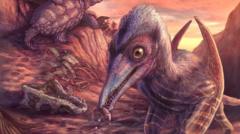Teeth marks embedded in a fossilized leg bone of an avian predator known as a "terror bird" indicate a fatal encounter with a larger predator, likely a species of caiman. This revelation has emerged from recent research conducted by Colombian palaeontologists, who utilized 3D scans to analyze the bite marks. Terror birds, which stood over 2.5 meters tall and possessed formidable beaks and legs, were among the top predators of their time. The study, published in Biology Letters, details this extraordinary interaction between two apex predators.
This particular leg bone, discovered over 15 years ago in Colombia's Tatacoa Desert, dates back to a time when the region was a humid swamp teeming with life. Researchers focused on the bite marks, comparing them to the teeth of extinct crocodilian species housed in museum collections. Lead researcher Andres Link from the Universidad de Los Andes stated that these marks indicate either the bird's death in the attack or the possibility of scavenging. He noted the absence of healing signs, emphasizing the severity of the assault.
The caiman in question is believed to be Purussaurus neivensis, a fearsome predator reaching lengths of up to five meters. The researchers speculate that this ancient caiman likely utilized ambush tactics to hunt similar to its modern counterparts. This study provides crucial insight into how terror birds, once thought to be invulnerable, faced formidable threats themselves within their ecosystems.
Local fossil collector César Augusto Perdomo's earlier discovery of the leg bone led to the study’s findings, underscoring the importance of individual fossils in piecing together the history of life on Earth. Dr. Link remarked on the astonishing potential each fossil holds, contributing significantly to our understanding of ancient biodiversity and predator-prey dynamics. The analysis of this leg bone not only enhances our knowledge of terror birds but also reveals insights into the complexities of prehistoric environments, showcasing the interconnectivity of life throughout geological history.


















